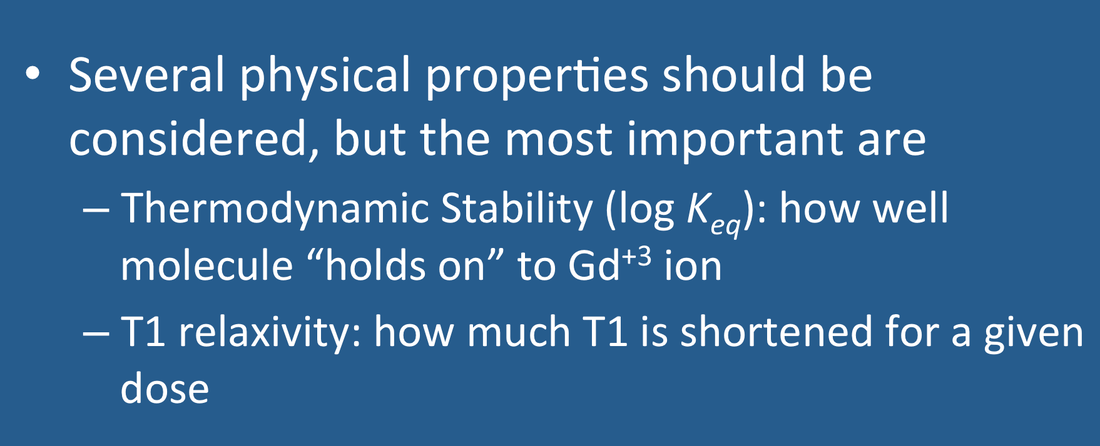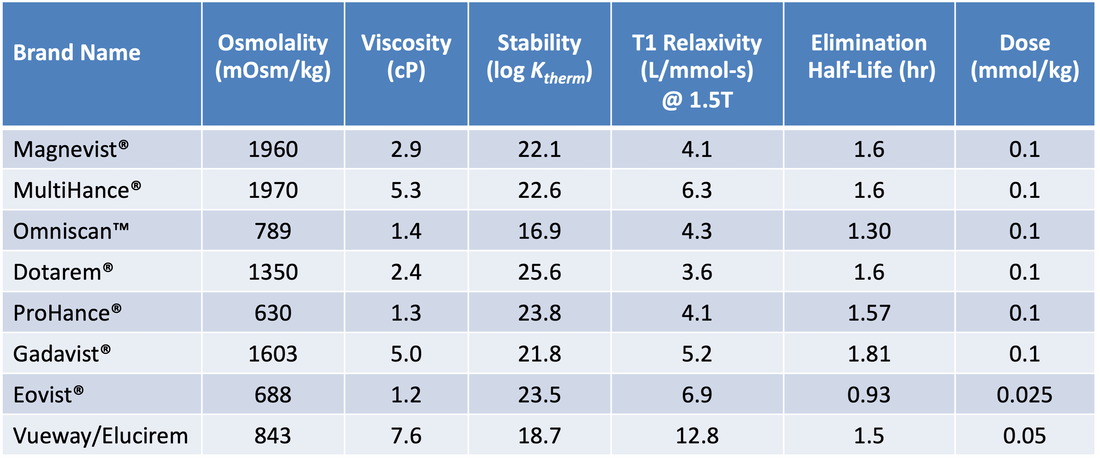The table below lists several key physical properties of commercially-available gadolinium-based contrast media that should be considered when selecting an agent. In this and other tables I have used the brand names rather than chemical names since these will likely be more familiar to readers.
1. Osmolality. Osmolality reflects the concentration of dissolved particles in a contrast agent's formulation. Values range between 630 and 1970 mOsm/kg of water where 1 mOsm = 1 "milli-osmole" = 1/1000 of a mole. The osmolality of a contrast agent is closely related to whether it is ionic or non-ionic. The clinical differences between low and high osmolality gadolinium agents is not nearly as important as differences between similar classes of iodine-based agents. (See ionic/non-ionic Q&A).
2. Viscosity. Viscosity is a measure of the "thickness" and internal resistance to motion of a fluid. For contrast agents the units are typically given in centiPoise (cP), where 1 cP = 1 g/m-s. The viscosities of contrast agents are in a range similar to that of whole blood with minor differences among them. Generally viscosity is not a major concern for standard doses and injection rates, but could be important for small caliber IVs and rapid injections.
3. Thermodynamic stability. The equilibrium constant (Ktherm) is an important parameter to note as it reflects how tightly the Gd ion is bound to its ligand. This value is presented on a logarithmic scale, with larger values representing exponentially tighter binding. It is no coincidence that the contrast agent with the lowest Ktherm (Omniscan®) has been associated with the highest reported rate of associated nephrogenic systemic fibrosis (NSF), a disease believed due to the deposition of free Gd in tissues. Selecting an agent with a high Ktherm is especially important in patients with renal insufficiency who are at risk for NSF. The structure of the ligand (linear vs macrocyclic) is also important, as less free gadolinium in tissues has been recorded for the macrocyclic agents independent of the Ktherm. The video below explains these concepts in a little more detail.
4. Relaxivity. Relaxivity is a measure of the degree to which a given amount of contrast agent shortens T1 or T2. This is obviously a very important metric as accelerated relaxation is the main purpose of administering contrast! Higher values are better. Higher relaxivities are associated with larger ligands and the propensity of the agent to bind with serum proteins. Gadopiclenol (Vueway™/Elucirem™) is an exception, as it has fairly large ligands but little protein binding.
5. Elimination half-life. Extracellular gadolinium contrast agents all share a common pharmacology. Within minutes of intravenous injection, they distribute rapidly throughout the extracellular interstitium. They are not metabolized and nearly completely eliminated by passive renal filtration, resulting in an biological half-life of approximately 1½ hours in patients with normal renal function. The elimination half-life is shortest for Eovist® due to its combined renal and hepatobiliary excretion.
6. Dose. The recommended dose of all gadolinium contrast agents is given on a per kilogram basis. The standard dose is 0.1 mmol/kg for most agents, the only exceptions being for Eovist® dosed at 0.025 mmol/kg and Vueway™/Elucirem™ dosed at 0.05 mmol/kg.
Advanced Discussion (show/hide)»
No supplementary material yet. Check back soon!
References
Behzadi AH, Zhao Y, Farooq Z, Prince MR. Immediate allergic reactions to gadolinium-based contrast agents: a systemic review and meta-analysis. Radiology 2018; 286:471-482. (Surprisingly, Omniscan had the lowest rate of reactions, and macrocyclics had higher rates than linear agents)
Bellin M-F, Van Der Molen AJ. Extracellular gadolinium-based contrast media: an overview. Eur J Radiol 2008; 66:160-167.
Laurent S, Vander Elst L, Muller RN. Comparative study of the physicochemical properties of six clinical low molecular weight gadolinium contrast agents. Contrast Media Mol Imaging 2006;1:128-137.
Robin C, Port M, Rousseaux O, et al. Physicochemical and pharmacokinetic profiles of gadopiclenol. A new macrocyclic gadolinium chelate with high T1 relaxivity. Invest Radiol 2019; 54:475-484. [DOI LINK]
Rohrer M, Bauer H, Mintorovitch J et al. Comparison of magnetic properties of MRI contrast media solutions a different magnetic field strengths. Invest Radiol 2005; 40:715-724.
Behzadi AH, Zhao Y, Farooq Z, Prince MR. Immediate allergic reactions to gadolinium-based contrast agents: a systemic review and meta-analysis. Radiology 2018; 286:471-482. (Surprisingly, Omniscan had the lowest rate of reactions, and macrocyclics had higher rates than linear agents)
Bellin M-F, Van Der Molen AJ. Extracellular gadolinium-based contrast media: an overview. Eur J Radiol 2008; 66:160-167.
Laurent S, Vander Elst L, Muller RN. Comparative study of the physicochemical properties of six clinical low molecular weight gadolinium contrast agents. Contrast Media Mol Imaging 2006;1:128-137.
Robin C, Port M, Rousseaux O, et al. Physicochemical and pharmacokinetic profiles of gadopiclenol. A new macrocyclic gadolinium chelate with high T1 relaxivity. Invest Radiol 2019; 54:475-484. [DOI LINK]
Rohrer M, Bauer H, Mintorovitch J et al. Comparison of magnetic properties of MRI contrast media solutions a different magnetic field strengths. Invest Radiol 2005; 40:715-724.
Related Questions
So many gadolinium contrast agents are now available. What are the differences among them?
So many gadolinium contrast agents are now available. What are the differences among them?

